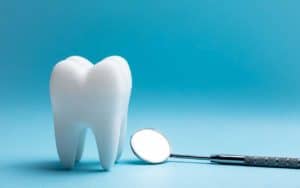A cavity first forms when bacteria demineralize enamel, the outer aspect and hardest part of the tooth surface. When bacteria are allowed to sit on teeth, a plaque biofilm forms. Most of the bacteria are naturally occurring throughout our mouths, but are given an opportunity to thrive upon consuming food and drinks that contain sugar. The growth of the plaque biofilm produces acids. Once acids weaken the enamel, they are left to attack the next and softer portion of our teeth, the dentin. Bacteria can come in contact with the most inner layer of the tooth, the pulp. The pulp can become irritated and one may feel discomfort while chewing, and, in more advanced stages, it is possible to experience pain or swelling. As the bacterial insult progresses, the body mounts an immune response to fight the initial insult to the tooth. This can lead to an abscess, which may require a root canal or extraction. The best way to prevent cavities is proper home care: brushing twice daily with a fluoride toothpaste, flossing once daily, and minimizing sweet, sticky foods and beverages – all of which can greatly reduce the risk of cavities. Regular visits to your dentist can help reduce the risk of cavities and halt the progression before they become too advanced. The dental visit usually involves x-rays or radiographs once a year to assess the areas of the teeth that cannot be viewed clinically. Various filling materials can be used to fill cavities, your dentist will recommend which type of material is best for you. If your dentist does find a cavity, do not fret, it’s not uncommon to have cavities. Tooth decay is preventable! Regular dental visits, proper oral hygiene, and good eating habits can save your teeth!

Rhinebeck Dental Care, www.rhinebeckdentalcare.com
